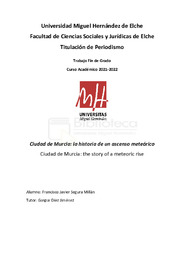Por favor, use este identificador para citar o enlazar este ítem:
https://hdl.handle.net/11000/27867Registro completo de metadatos
| Campo DC | Valor | Lengua/Idioma |
|---|---|---|
| dc.contributor.advisor | Díez Jiménez, Gaspar | - |
| dc.contributor.author | Segura Millán, Francisco Javier | - |
| dc.contributor.other | Departamentos de la UMH::Ciencias Sociales y Humanas | es_ES |
| dc.date.accessioned | 2022-10-11T10:10:17Z | - |
| dc.date.available | 2022-10-11T10:10:17Z | - |
| dc.date.created | 2022-06-13 | - |
| dc.identifier.uri | https://hdl.handle.net/11000/27867 | - |
| dc.description.abstract | En los últimos tiempos, no hay un año en el que un equipo de fútbol no desaparezca. El motivo principal suele ser una mala gestión económica que acaba desembocando en la quiebra de la entidad. La historia del Ciudad de Murcia es diferente. Creado por Enrique Pina, uno de los agentes y “personajes” más reconocidos del fútbol español, el proyecto empezaría a crecer hasta llegar en apenas cuatro años a Segunda División. Durante todo este proceso pasaron sucesos sorprendentes, desde contar como compañero de entrenamientos a Pep Guardiola hasta los inicios de un ganador de una Eurocopa como es Dani Güiza. La desaparición del club murciano sería diferente a la de los otros equipos. Unas discrepancias entre Quique Pina y el Ayuntamiento de Murcia debidas a la no concesión de un proyecto urbanístico acabarían llevando al Ciudad de Murcia a la extinción. Esta problemática llevaría al presidente del Ciudad a poner el club en venta, pasando a ser el primer club del balompié nacional en vender su plaza a un equipo de otra ciudad. | es_ES |
| dc.description.abstract | In recent times, there is not a year in which a soccer team does not disappear. The main reason is usually poor economic management that ends up leading to the bankruptcy of the entity. The history of Ciudad de Murcia is different. Created by Enrique Pina, one of the most recognized agents and "characters" in Spanish soccer, the project began to grow until it reached the Second Division in just four years. Throughout this process, surprising events happened, from having Pep Guardiola as a training partner to the beginnings of a Eurocup winner such as Dani Güiza. The demise of the Murcian club would be different from that of the other teams. Disagreements between Quique Pina and the Murcia City Council due to the non-granting of an urban development project would end up leading Ciudad de Murcia to extinction. This problem would lead the president of Ciudad to put the club up for sale, becoming the first national football club to sell its place to a team from another city. | es_ES |
| dc.format | application/pdf | es_ES |
| dc.format.extent | 19 | es_ES |
| dc.language.iso | spa | es_ES |
| dc.publisher | Universidad Miguel Hernández de Elche | es_ES |
| dc.rights | info:eu-repo/semantics/openAccess | es_ES |
| dc.rights | Attribution-NonCommercial-NoDerivatives 4.0 Internacional | * |
| dc.rights.uri | http://creativecommons.org/licenses/by-nc-nd/4.0/ | * |
| dc.subject | fútbol | es_ES |
| dc.subject | desaparición | es_ES |
| dc.subject | venta | es_ES |
| dc.subject | ascenso | es_ES |
| dc.subject | football | es_ES |
| dc.subject | dissappear | es_ES |
| dc.subject | sell | es_ES |
| dc.subject | promotion | es_ES |
| dc.subject.other | CDU::0 - Generalidades.::070 - Periódicos. Prensa. Periodismo. Ciencias de la información | es_ES |
| dc.title | Ciudad de Murcia: la historia de un ascenso meteórico | es_ES |
| dc.title.alternative | Ciudad de Murcia: the story of a meteoric rise | es_ES |
| dc.type | info:eu-repo/semantics/bachelorThesis | es_ES |

Ver/Abrir:
TFG-Segura Millán, Francisco Javier.pdf
720,93 kB
Adobe PDF
Compartir:
 La licencia se describe como: Atribución-NonComercial-NoDerivada 4.0 Internacional.
La licencia se describe como: Atribución-NonComercial-NoDerivada 4.0 Internacional.
.png)